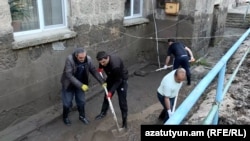Flood waters inundated on Sunday dozens of towns of villages in the Lori and Tavush provinces, killing four people and causing extensive damage to local transport infrastructure. The government formally declared about a dozen of those settlements a disaster zone on Monday, allocating 300 million drams ($775,000) for urgent relief supplies to their residents.
Minister of Territorial Administration and Infrastructures Gnel Sanosian said it now needs hundreds of volunteers to assist local authorities in their unfolding cleanup efforts.
“There seems to be no shortage of construction equipment, but in a number of areas only manual work is possible,” Sanosian told RFE/RL’s Armenian Service. “Inside buildings, their entrances, shops and other places there is a fairly thick layer of mud and damaged products that can be removed mainly by manual work.”
Education Minister Zhanna Andreasian urged university students in Yerevan and other parts of the country to join in those efforts. She said “many” of them have already done so.
The appeals prompted scathing comments from some supporters of the Armenian opposition. They pointed to the government’s apparent reluctance to send police and interior troops to the flooded areas for that purpose. Scores of security forces remain deployed in Yerevan amid continuing antigovernment protests that began there on May 9.
Some citizens volunteered to help the affected Lori and Tavush residents at their own initiative. Seyran Galstian, a resident of a village in the Armavir province west of Yerevan, was in the Lori town of Alaverdi on Tuesday, shoveling mud from the stairwell of an apparent block flooded on Sunday.
Others collected donations and bought food for communities that remain cut off from the rest of the country because of severe damage to local roads and bridges. Anna Hovannisian, a blogger based in Lori, said she bought food with 1 million drams ($2,500) raised on her Facebook page and delivered it to rescue workers communicating with stranded residents.
“Things are a bit chaotic,” she said. “There is no clearly regulated sequence of [government] steps, no lists and numbers of people in need. We’re using our own channels to try to ascertain … who needs what.”





